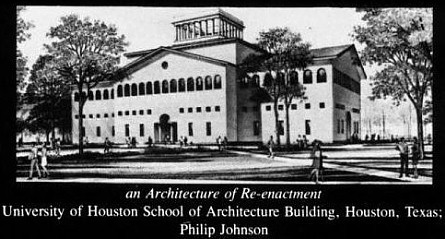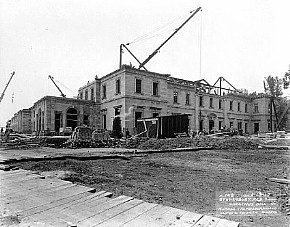2000.06.13
the need for a plan of action
...may find a whole new methodology emerge while becoming more comfortable with the ease of putting publications together. For example, composing a book entitled [architectural] non-sequiturs using the eBay images, plus all other kinds of architectural images (eg. cad, mavica) and the “text” will read like Hey Art... or even something newer.
2004.06.13 09:28
cloning architecture - a global search
The State Capitol of Pennsylvania is fairly exact though shrunk copy of the St. Peter's Rome. See also the Cathedral of Montreal.
Herrenchiemsee of Ludwig II, the ultimate Versailles, sigh.
The Philadelphia Museum of Art is very similar to the Academy of Athens.
There are reenactionary Choragic Monuments in (at least) Philadelphia and Berlin.
The Free Library and the Family Courthouse of Philadelphia reenact the Place de la Concorde.
What is cloning if not reenactment?
| |
The answer is that to re-enact the past in the present is to re-enact it in a context which gives it a new quality. This context is the negation of the past itself. Thus, the historian of poetry, reading Dante, re-enacts the medieval experience himself which that poem expresses: but while doing this he remains himself: he remains a modern man, not a medieval: and this means that the medievalism of Dante, while genuinely revived and re-experienced within his mind, is accompanied by a whole world of fundamentally non-medieval habits and ideas, which balance it and hold it in check and prevent it from ever occupying the whole field of vision.1
Therefore, the performance can never end or even progress in the conventional sense of dramatic plotting; it can only be the cyclic restatement of a single theme: creation and destruction irrevocably interlocked, endlessly reenacted.2
[The campus of Columbia University] is rather an architectural reenactment of a Renaissance reenactment of a dreamt classical city believed to be real, and because it is a city in connotation it can and does emblemize the city it is part of.3
 4 4
The paper concludes, moreover, that the making of the Campo Marzio interpretively re-enacts the original imaginative founding of the Eternal City and, as such, constitutes an attempt to re-found Heroic Rome.5
When I first began to redraw Piranesi's Campo Marzio using CAD [in 1987], I was doing so to get as close to Piranesi as possible; essentially, I was reenacting his act of drawing as best I could. For me, this exercise, this reenactment, has provided enormous insight albeit it took several years of continual work for this vision to develop. I am certainly not Piranesi, nor do I contend to possess his superior creative talent and imagination, but I deliberately attempted to do some of the same things he has done, and in so doing I honestly believe I removed several degrees of separation. Perhaps reenactments then are always a play with degrees of separation, sometimes seeing how close one can get to the 'original' and/or sometimes seeing how far one can "stretch the truth," to name the extreme cases. 6
It is no accident that the New in the arts always announces itself in the guise of a revival, Hadid's career starts with the reinterpretation of Malevich's Teltonik, and her early work has indeed been (mis-)understood as neo-Constructivism. In a similar fashion, Peter Eisenman is said to take off from early Le Corbusier and Terragni. Revivalist appropriation is the easiest and most immediate option to articulate dissatisfaction and resistance towards a dominant practice. However, this has nothing to do with repetition. For instance, to pick up the unfinished projects of modernism on the back of postmodernism cannot be simple re-enactment, even if one initially works with direct citations. 7
...where the New York-based Clifford Owens performs the work of Fluxus member Benjamin Patterson; and where the collective Continuous Project reenact art-world panel discussions from decades before, as they did in the recent exhibition "Wieder and Wider: Performance Appropriated" at Vienna's Museum Moderner Kunst Stiftung Ludwig--to say nothing of more general gestures toward art history by Lucy McKenzie and Paulina Olowsja in their salon-cum-bar and performances evoking the early modernist avant-garde, and by Daria Martin in her films reflecting the strong influence of modern performance and dance
In fact, the past few years have seen a flurry of exhibitions devoted to this phenomenon. "Life, Once More: Forms of Reenactment in Contemporary Art," at Rotterdam's Witte de With in 2005, queried the status of such representations of historical actions and events, and to this end included Sullivan's aforementioned piece along with, for instance, the earlier example of Andrea Fraser's own performance of a drunken speech once given by Martin Kippenberger.8
1. R. G. Collingwood, The Idea of History (Oxford: Clarendon Press, 1946), p. 447.
2. Rem Koolhaas, Delirious New York (1978).
3. Arthur C. Danto, "Building Metaphors" in PRECIS: Beyond Style (Rizzoli, 1984), p. 99.
4. Michael Benedikt, For an Architecture of Reality (1988), p. 29.
5. Robert Aitken, "PIRANESI - VICO - Il Campo Marzio: Foundations and the Eternal City" (McGill University: Master's Thesis, 1995).
6. Stephen Lauf, "reenactment" (design-l listserv, 1999.11.09).
7. Patrik Schumacher, "Mechanism of Radical Innovation" in Zaha Hadid Complete Works: Texts and References. p. 65.
8. Melanie Gilligan, "The Beggar's Pantomine" (Artforum, Summer 2007), p. 428.
| |
10061301 Atheneum plans section elevation with other museum plans 2231i01
10061302 Kimbell Art Museum plan section elevation with other museum plans 2210i01
10061303 Gallaratese Housing Block plans elevations with other domestic plans 2214i01
10061304 Casa da Musica plans sections with the Danteum plan 2320i01
11061301 Brant House + addition plan scans 221ai01
| |
2014.06.13 13:59
The 2014 U.S. Venice Biennale pavilion reinterprets 100 years of American architecture
No doubt Rita Novel would put together an exhibit of American buildings that shouldn't have been built in the first place, entitled Better Never Than Quondam.
14061301 Retreat House elevations 2237i10
15061301 Eileen Gray E1027 Roquebrune-Cap-Martin
16061301 GAUA S02 IQ28 block inverted opaque
16061302 GAUA S02 IQ28 Cubist ICM infill 2429i187
16061303 GAUA S03 IQ28 block inverted opaque
16061304 GAUA S03 IQ28 Cubist ICM infill 2429i188
18061301 Pantheon Paradigm sector 6 plans 4400x2200 243bi32
18061302 Pantheon Paradigm sector 7 plans 4400x2200 243bi33
18061303 Pantheon Paradigm sector 8 plans 4400x2200 243bi34
19061301 San Stefano plans work image 207ei02
19061302 Mayor's House plan San Stefano plan image 2269i11
19061303 Park of Versailles Mount Pleasant Whitemarsh Hall Wissenhof Siedlung iqq22 plans 2092i45
21061301 Infringement Complex Pantheon Complex plans 2308i05
|


 4
4